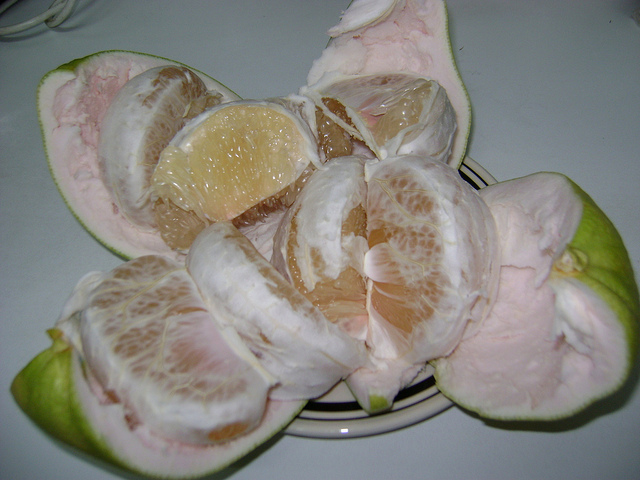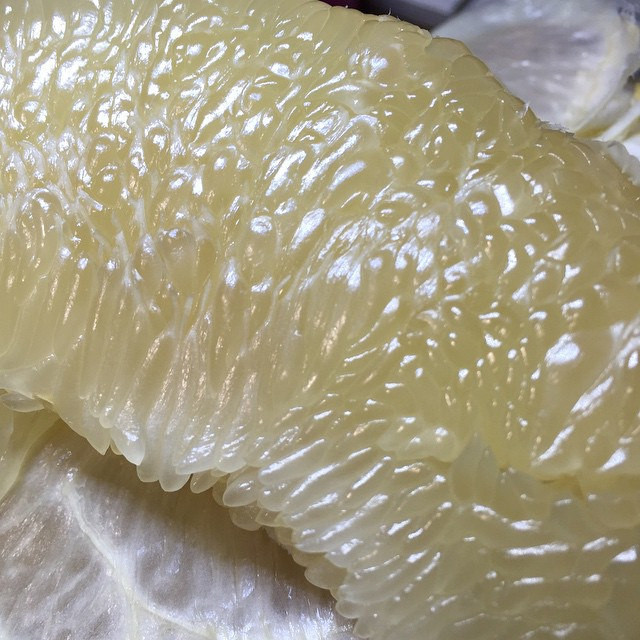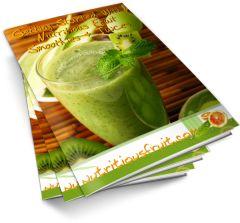Pomelo: Origins - Consumption - Nutrition Facts - Health Benefits
|
|
|
Contents
- Geographic origin and regions grown
- History of consumption
- Common consumption today
- Nutrition Facts: Vitamins, minerals and phytochemical components
- Health Benefits: Medicinal uses based on scientific studies
- Bibliography
Geographic Origins and Regions Grown

The pomelo is a citrus fruit that goes by many names. Common names for the pomelo include: Citrus maxima, Chinese grapefruit, pommelo, boongon, Jeruk Bali, jabong, shaddock, suha, Citrus grandis, and Jeruk Bali. It is larger than a grapefruit, it has a sweet flesh, a thick spongy rind, and its color ranges from pale green to yellow when it is ripe.
The pomelo is not to be confused with the yuzu, which uses the same Chinese characters but is a different species. It is called Som O in Thai, and buntan or banpeiyu in Japanese. In Burmese it is called kywègaw thee in the South and shaupann thee in the North.
The color of its pulp ranges between clear pale yellow to pink or red and tastes like a sweet, mild grapefruit. It is currently described as the largest citrus fruit, growing as large as 30 cm in diameter and weighing as much as 10 kg. The peel is thick and is sometimes used to make marmalade. The tangelo is a hybrid between the pomelo and the tangerine. It has a thicker skin than a tangerine and is less sweet.
The peel of the pomelo is also used in Chinese cooking or use as a sweetener to make candies. In general, the citrus peel is often used in southern Chinese cuisine for flavoring, especially in sweet soup desserts.
History of Consumption
The pomelo is native to Southeast Asia and all of Malaysia. It grows wild on the river banks of Fiji, Tonga, and Hawaii. It may have been introduced in China around 100 B.C. Nowadays the pomelo is cultivated mainly in the Jiangsu, Jiangxi, and Fujian provinces of southern China.
They are also cultivated along the Tha Chin River of central Thailand, in the Philippines, Bangladesh, Japan, Myanmar, Tahiti,
southern India, Indonesia, Vietnam, New Guinea, and Malaysia. Pomelo are also sold commercially in Israel, Florida, and California.
The pomelo is also known as a shaddock, after an English sea captain, Captain Shaddock, who introduced the seed to the West Indies in the 17th century from the Malay Archipelago. In the Pacific and Asia, it is known as jabong and in Chinese it is called yòuzi.
Common Consumption Today
The pomelo is often served halved and sprinkled with sugar. In addition, it can be used in salads or as a garnish for duck, chicken, pork, and shrimp dishes.
Nutrition Facts: Vitamins, Minerals and Phytochemical Components

Pomelos are a good source of vitamin C, iron, potassium, and calcium.
Health Benefits: Medicinal Uses Based on Scientific Studies
Pomelos provide a large supply of Vitamin C (4). Vitamin C is an antioxidant that has many functions such as the promotion of healthy skin and gums and the ability to increase iron absorption from non-meat iron sources (iron-rich grains and other plant foods such as whole-grain cereals) when ingested at the same time as the iron (1), (2).
To date, there are not many studies that confirm the presence of dietary fiber and folic acid in pomelos, but one can assume that this member of the citrus family contains levels similar to its counterparts such as oranges, tangerines, and clementines. Folate helps strengthen healthy red blood cells. Folate has additional health benefits including the reduction of neural tube birth defects during pregnancy (3).
Folate also helps produce and maintain new somatic cells. This is especially important during periods of rapid cell division and growth such as during infancy and pregnancy. Folate is needed by the body to make DNA and RNA, which are the building blocks of cells. It also helps prevent changes to DNA that may lead to cancer.
Both adults and children need folate to make normal red blood cells and prevent anemia. Folate is also essential for the metabolism of homocysteine and helps maintain normal levels of this amino acid (5).
Bibliography
1. Akhilender-Naidu K. (2003) Vitamin C in human health and disease is still a mystery? An overview. Nutrition Journal, 2:7.
2. Chiplonkar SA, Tarwadi KV, Kavedia RB, Mengale SS, Paknikar KM, Agte VV. (1999) Fortification of vegetarian diets for increasing bioavailable iron density using green leafy vegetables. Food Research International, 32(3):169-174.
3. Christensen B, Rosenblatt DS. (1995) Effect of folate deficiency on embryonic development. Review. Baillieres Clinical Haematology, 8(3):617-37.
4. Liver Support.Com. (2007) Mandarin Oranges to Prevent Liver Cancer. Retrieved on December 10, 2007 from http://www.liversupport.com/wordpress/2007/01/ mandarin-oranges-to-prevent-liver-cancer
5. National Institute of Health, Office of Dietary Supplements. (2007) Dietary Supplement Fact Sheet: Folate. Retrieved Decemeber 8, 2007 from http://dietary-supplements.info.nih.gov/factsheets/folate.asp
Disclaimer
Nutritiousfruit.com provides this website as a service. Although the information contained within the website is periodically updated, no guarantee is given that the information provided is correct, complete, and/or up-to-date. The materials contained on this website are provided for general information purposes only and do not constitute legal or other professional advice on any subject matter. Nutrtiousfruit.com does not accept any responsibility for any loss, which may arise from reliance on information contained on this website. The information and references in this website are intended solely for the general information for the reader. The content of this website are not intended to offer personal medical advice, diagnose health problems or to be used for treatment purposes. It is not a substitute for medical care provided by a licensed and qualified health professional. Please consult your health care provider for any advice on medications.
Didn't find what you were looking for? Search here...

Amazon Search Box:
Did you like this page?
|
|
|




